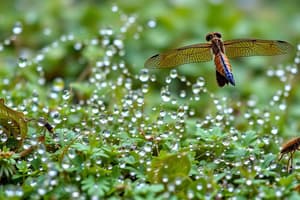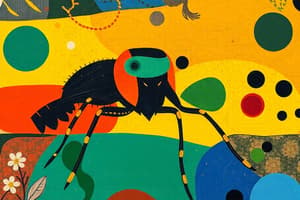Podcast
Questions and Answers
How does the availability of food influence the survival of organisms?
How does the availability of food influence the survival of organisms?
- It provides energy for all living things to carry out essential processes. (correct)
- It only affects plant species.
- It has no significant impact on survival.
- It limits competition among species.
What impact can disease-causing organisms have on a population?
What impact can disease-causing organisms have on a population?
- They only affect plants, leaving animal populations unharmed.
- They foster genetic diversity by acting on weak individuals.
- They can enhance the population size by promoting competition.
- They can cause significant decline or complete wipeout of the population. (correct)
What is a consequence of having too many predators in a habitat?
What is a consequence of having too many predators in a habitat?
- It increases the genetic diversity of the prey species.
- It decreases competition for food.
- It can lead to a decline in the prey population competing for resources. (correct)
- It protects the habitat by controlling the population balance.
What effect does a flood have on the environment?
What effect does a flood have on the environment?
How does drought affect organisms that rely on water?
How does drought affect organisms that rely on water?
Which organisms are found in the pond habitat?
Which organisms are found in the pond habitat?
What is a defining characteristic of a community as mentioned?
What is a defining characteristic of a community as mentioned?
Which habitat would you expect to find a slug and an earthworm?
Which habitat would you expect to find a slug and an earthworm?
Which of the following organisms is NOT found in a seashore habitat?
Which of the following organisms is NOT found in a seashore habitat?
What type of environment is leaf litter described as?
What type of environment is leaf litter described as?
What is the definition of a population?
What is the definition of a population?
Which factors contribute to an increase in population size?
Which factors contribute to an increase in population size?
How do animal populations depend on plants?
How do animal populations depend on plants?
What leads to a decrease in population size?
What leads to a decrease in population size?
Which of the following statements about plant populations is true?
Which of the following statements about plant populations is true?
What is the primary function of a food web in an ecosystem?
What is the primary function of a food web in an ecosystem?
How does a decrease in prey populations directly affect predators?
How does a decrease in prey populations directly affect predators?
What is likely to happen if a new predator is introduced into a food web?
What is likely to happen if a new predator is introduced into a food web?
Which of the following statements about food webs is true?
Which of the following statements about food webs is true?
Which sequence correctly represents a food chain in a food web?
Which sequence correctly represents a food chain in a food web?
What is the role of producers in a food chain?
What is the role of producers in a food chain?
Which type of consumer exclusively feeds on plants?
Which type of consumer exclusively feeds on plants?
In a food chain, what direction do the arrows indicate?
In a food chain, what direction do the arrows indicate?
What percentage of energy is typically passed on to the next consumer in a food chain?
What percentage of energy is typically passed on to the next consumer in a food chain?
Which of the following organisms would be classified as a decomposer?
Which of the following organisms would be classified as a decomposer?
Which statement accurately describes carnivores?
Which statement accurately describes carnivores?
What role do herbivores play in a food web?
What role do herbivores play in a food web?
Which statement is true regarding energy transfer in a food chain?
Which statement is true regarding energy transfer in a food chain?
What is included in the non-living factors of an organism's environment?
What is included in the non-living factors of an organism's environment?
How does temperature affect water availability for organisms?
How does temperature affect water availability for organisms?
Which of the following is essential for plants to carry out photosynthesis?
Which of the following is essential for plants to carry out photosynthesis?
What role does soil play in the environment of plants?
What role does soil play in the environment of plants?
Which statement about aquatic organisms is true?
Which statement about aquatic organisms is true?
Which of the following statements is true regarding organisms and light?
Which of the following statements is true regarding organisms and light?
What effect does the amount of available air have on organisms?
What effect does the amount of available air have on organisms?
Which living factor can most directly impact the survival of a population of predators?
Which living factor can most directly impact the survival of a population of predators?
Flashcards
Environmental factors
Environmental factors
All the living and non-living things that affect an organism's survival.
Non-living factors
Non-living factors
Physical characteristics that influence organisms.
Temperature
Temperature
Organisms need a specific range for survival.
Oxygen ($O_2$)
Oxygen ($O_2$)
Signup and view all the flashcards
Water
Water
Signup and view all the flashcards
Light
Light
Signup and view all the flashcards
Soil
Soil
Signup and view all the flashcards
Living Factors
Living Factors
Signup and view all the flashcards
Food Chain Impact
Food Chain Impact
Signup and view all the flashcards
Disease Outbreak
Disease Outbreak
Signup and view all the flashcards
Predator-Prey Relationship
Predator-Prey Relationship
Signup and view all the flashcards
Flood Impacts
Flood Impacts
Signup and view all the flashcards
Drought's Impact
Drought's Impact
Signup and view all the flashcards
What is a population?
What is a population?
Signup and view all the flashcards
What factors increase population size?
What factors increase population size?
Signup and view all the flashcards
What factors decrease population size?
What factors decrease population size?
Signup and view all the flashcards
How do animals depend on plants?
How do animals depend on plants?
Signup and view all the flashcards
How do plants depend on animals?
How do plants depend on animals?
Signup and view all the flashcards
Community
Community
Signup and view all the flashcards
Interdependence in a Community
Interdependence in a Community
Signup and view all the flashcards
Habitat
Habitat
Signup and view all the flashcards
What are the residents of a Rotting Log?
What are the residents of a Rotting Log?
Signup and view all the flashcards
Leaf Litter: Perfect Home
Leaf Litter: Perfect Home
Signup and view all the flashcards
Producer
Producer
Signup and view all the flashcards
Consumer
Consumer
Signup and view all the flashcards
Food Chain
Food Chain
Signup and view all the flashcards
Herbivore
Herbivore
Signup and view all the flashcards
Carnivore
Carnivore
Signup and view all the flashcards
Omnivore
Omnivore
Signup and view all the flashcards
Decomposer
Decomposer
Signup and view all the flashcards
Energy Transfer
Energy Transfer
Signup and view all the flashcards
Food Web
Food Web
Signup and view all the flashcards
How does removing a species affect a food web?
How does removing a species affect a food web?
Signup and view all the flashcards
How does adding a species affect a food web?
How does adding a species affect a food web?
Signup and view all the flashcards
What is the importance of predator-prey relationships?
What is the importance of predator-prey relationships?
Signup and view all the flashcards




